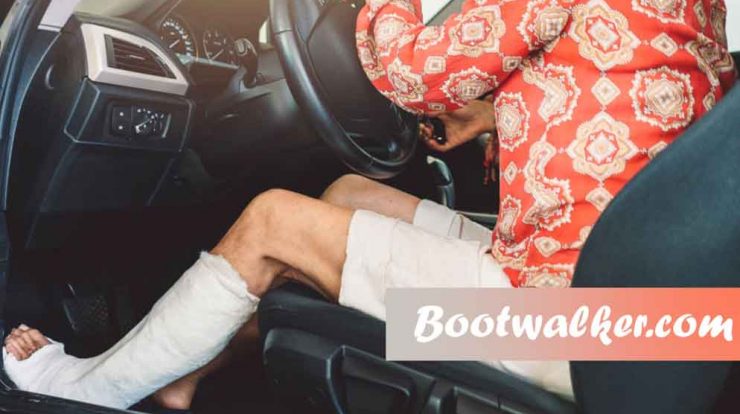
No matter what job you are doing, the last thing anyone wants to deal with is a broken bone and the inconvenience that come with it, but as it happens things occur in life that we have no control over.
As it is always been said, life happens. At some point in our lives, we may find ourselves in a cast, splint, sling or brace.
Matter are a bit severe when you break a bone in your leg and have to take a break while our bones repair themselves. Unfortunately, most of us can’t afford to stop driving or hire a chauffeur to drive us to and from work.
I am a traveling salesperson and I’ve broken my left foot. It feels like my life has ended! Just sitting around not doing anything, I know the worst thing can happen, but why me? I drive an automatic car.
The question is, can you drive with a broken left foot? The simple answer is yes and no. Yes, if your car is an automatic or an electric car then you are technically able to drive without any problems.
On the other hand, No, if your car is a manual transmission car, as you will need your left foot to depress the clutch pedal, which is a problem since you will not have the full range of motion in the leg.
There are further things to consider, you will need to consider if it is too risky to be driving with a walking boot, or worst, is it even legal for you to drive with a broken leg in a boot walker. Continue reading this article for the answers…
Can you drive with a broken left foot? Or is it just too risky
If your right foot is broken and, in a cast, it may not be possible for you to drive. You will need your right foot to control the pedals in the car. So, if you were considering to drive with a cast on your right foot, think again. Take some time out, take a little vacation.
According to a new study from the Journal of Bone and Joint Surgery (JBJS), it takes much longer to brake when the driver is wearing an immobilization device — like a splint or brace than it does when wearing normal footwear (science daily, 2010).
The study found that if you’re driving at 60 miles per hour while wearing any type of control ankle immobilization boot, it can extend the braking distance by an additional 9.2 feet to stop completely during an emergency braking situation.
A person wearing a short cast or boot walker feared slightly better, the short cast adds 6.1 feet to the braking distance at the same speeds. These additional distances (9.2 and 6.1 feet) may seem insignificant, like nothing much, but the extra distance could mean the difference between having a total wreck, a light collision or a near miss.
Furthermore, if you have to take medication as part of your injury recovery then the risk of an accident increases, if you receive medication as part of your surgery, it is normally advised, by your doctor, not to drive.
Medication normally makes you drowsy, slowing dramatically your reaction time making it more likely to meet in an accident.
Countless individuals who wear casts on their feet take pain medications that contain substances like narcotics, or opioid pain relievers, such as codeine, oxycodone, and hydrocodone to numb the pain.
Consuming active medications while operating a vehicle can be dangerous. This is for the simple fact that narcotics can reduce reaction time and result in fatigue, which makes an accident more probable.
The best advice for individuals wearing foot casts is to consider taking taxis or asking friends and family to chauffeur them to work and appointments. It can be challenging but we have to learn to accept help sometimes.
Can you drive with a broken left foot? Or is it legal to drive?
If you are advised not to drive, then you should not, as it would be illegal to do so. Most insurance policies will be voided if you go against your doctor’s professional opinion not to drive. An accident could invalidate your insurance whether or not the walker boot was a factor.
While there is no specific law that states that you cannot drive with a broken left foot, the physical limitation may prevent you from doing so.
According to the University of Wisconsin, it is not illegal for a person to drive with a cast on; however, experts advise against it because of slower response times when moving from the accelerator to the brake or when engaging the clutch in a vehicle with a manual transmission.
Driving with walking boot: Getting Cleared to Drive by the insurance company
Some larger insurer will probably give the OK if your doctor gives you the go-ahead to drive. Unfortunately, doctors and surgeons can’t clear you to drive, let us say they won’t because of the risk of being blamed if something bad happens.
They would be liable if you get into an accident after they gave you permission. They will, however, educate you on the best way to drive safely.
The only way to make a legal determination of your driving ability is to take a test with an appropriately trained licensing authority, most typically your local Department of Motor Vehicles (DMV).
This is especially true if you are faced with a long-term recovery or have sustained permanent impairment as a result of an injury. Most state laws will dictate that you are incapable of driving if you are wearing a device (such as a splint, cast, or brace) that limits joint mobility.
Driving with a walking boot in an automatic car, does it make a difference?
Can you drive with a broken left foot in a car if it is automatic? I can’t see the problem myself in an automatic. If it was a manual transmission car then there might be a little problem because your left foot would have to depress the clutch in order to change gears.
You will have to park your lovely manual car and hitch a ride in the carpool until you are out of your cast. It will more than likely be only a few weeks.
Modern electric cars make it a bit safer because the car helps with lane keep plus the regeneration helps you to slow the car down to a stop without using the physical break.
Things to consider when driving with a walking boot
- If you’re wearing anything that’s designed to immobilize your foot and ankle, you are at a higher risk for getting into a car accident.
- Consider using a ridesharing service or public transportation if you don’t have full motion of your limbs.
- Your broken ankle or foot could hinder you escaping from your car if you need to
- Insurers may query any claims made if the injury existed prior to any accident you may encounter.
- If your injury is permanent you may need to inform your driver agency to amend your licence.
This article is not intended as legal advice. Always check with your local road authority to get the latest, most relevant information concerning your personal situation.
In your time of need, it is good to be able to seek the help of friends and be humble enough to accept help. I know sometimes it is a very difficult thing to do especially if you have always been an independent person.
Have you ever needed to drive with a broken leg? Tell us about it in the comments below.






